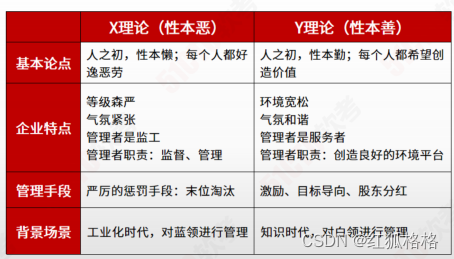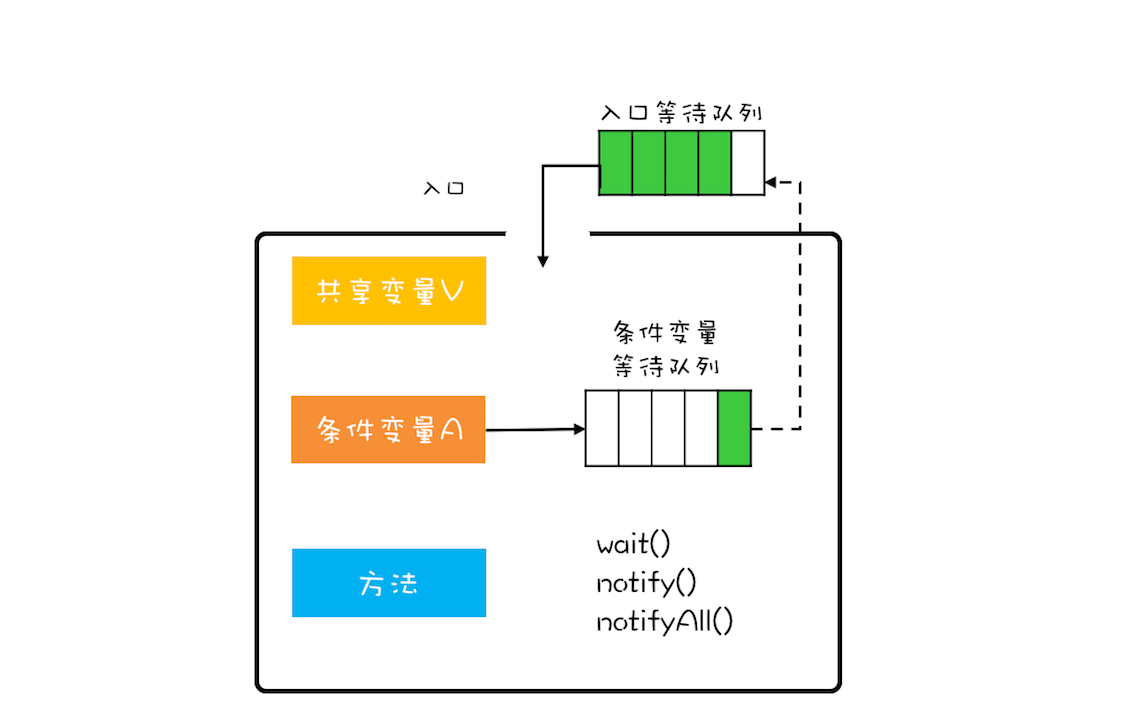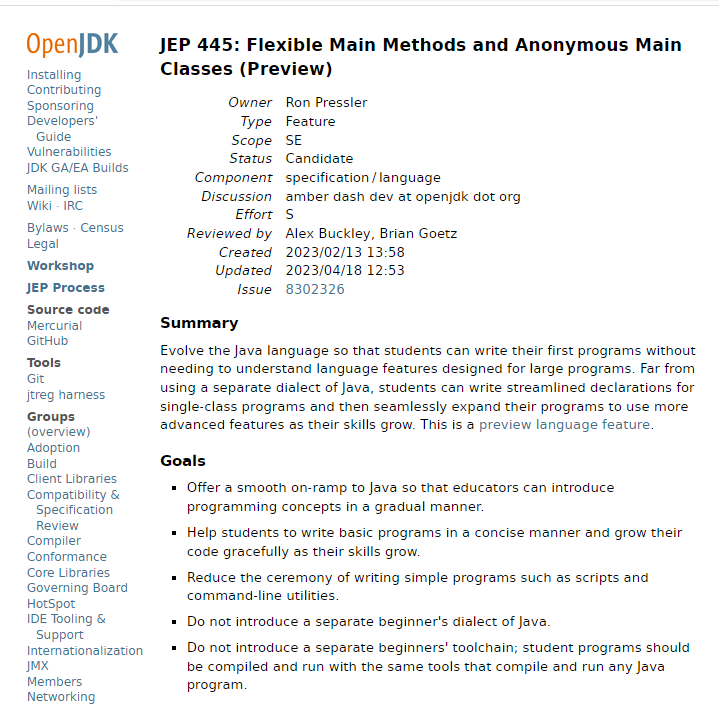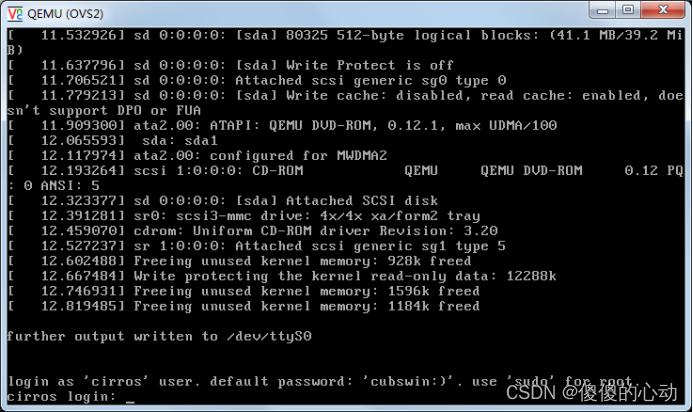Java基础入门-02
- 8、面向对象
- 8.1. 类和对象
- 8.1.1 类和对象的理解
- 8.1.2 类的定义
- 8.1.3 对象的使用
- 8.1.4 学生对象-练习
- 8.2. 对象内存图
- 8.2.1 单个对象内存图
- 8.2.2 多个对象内存图
- 8.3. 成员变量和局部变量
- 8.3.1 成员变量和局部变量的区别
- 8.4. 封装
- 8.4.1 封装思想
- 8.4.2 private关键字
- 8.4.3 private的使用
- 8.4.4 this关键字
- 8.5. 构造方法
- 8.5.1 构造方法概述
- 8.5.2 构造方法的注意事项
- 8.5.3 标准类制作
- 8.5.4 练习1
- 8.5.4 练习2
- 9、面向对象综合训练
- 扩展:键盘录入笔记
- 一,键盘录入涉及到的方法如下:
- 1)next()、nextLine():
- 代码示例:
- 代码示例:
- 2)nextInt():
- 代码示例:
- 3)nextDouble():
- 代码示例:
- 二,方法底层细节 :
- 第一个细节:
- 代码示例:
- 第二个细节:
- 第三个细节:
- 三、混用引起的后果
- 四、结论(如何使用)
- 代码示例:
- 练习一:文字版格斗游戏
- 练习二:文字版格斗游戏进阶
- 练习三:对象数组(商品)
- 练习四:对象数组(汽车)
- 练习五:对象数组(手机)
- 练习六:对象数组(女朋友)
- 练习七:复杂的对象数组操作
8、面向对象
8.1. 类和对象
8.1.1 类和对象的理解
客观存在的事物皆为对象 ,所以我们也常常说万物皆对象。
- 类
- 类的理解
- 类是对现实生活中一类具有共同属性和行为的事物的抽象
- 类是对象的数据类型,类是具有相同属性和行为的一组对象的集合
- 简单理解:类就是对现实事物的一种描述
- 类的组成
- 属性:指事物的特征,例如:手机事物(品牌,价格,尺寸)
- 行为:指事物能执行的操作,例如:手机事物(打电话,发短信)
- 类的理解
- 类和对象的关系
- 类:类是对现实生活中一类具有共同属性和行为的事物的抽象
- 对象:是能够看得到摸的着的真实存在的实体
- 简单理解:类是对事物的一种描述,对象则为具体存在的事物
8.1.2 类的定义
类的组成是由属性和行为两部分组成
- 属性:在类中通过成员变量来体现(类中方法外的变量)
- 行为:在类中通过成员方法来体现(和前面的方法相比去掉static关键字即可)
类的定义步骤:
①定义类
②编写类的成员变量
③编写类的成员方法
public class 类名 {
// 成员变量
变量1的数据类型 变量1;
变量2的数据类型 变量2;
…
// 成员方法
方法1;
方法2;
}
示例代码:
/*
手机类:
类名:
手机(Phone)
成员变量:
品牌(brand)
价格(price)
成员方法:
打电话(call)
发短信(sendMessage)
*/
public class Phone {
//成员变量
String brand;
int price;
//成员方法
public void call() {
System.out.println("打电话");
}
public void sendMessage() {
System.out.println("发短信");
}
}
8.1.3 对象的使用
- 创建对象的格式:
- 类名 对象名 = new 类名();
- 调用成员的格式:
- 对象名.成员变量
- 对象名.成员方法();
- 示例代码
/*
创建对象
格式:类名 对象名 = new 类名();
范例:Phone p = new Phone();
使用对象
1:使用成员变量
格式:对象名.变量名
范例:p.brand
2:使用成员方法
格式:对象名.方法名()
范例:p.call()
*/
public class PhoneDemo {
public static void main(String[] args) {
//创建对象
Phone p = new Phone();
//使用成员变量
System.out.println(p.brand);
System.out.println(p.price);
p.brand = "小米";
p.price = 2999;
System.out.println(p.brand);
System.out.println(p.price);
//使用成员方法
p.call();
p.sendMessage();
}
}
8.1.4 学生对象-练习
- 需求:首先定义一个学生类,然后定义一个学生测试类,在学生测试类中通过对象完成成员变量和成员方法的使用
- 分析:
- 成员变量:姓名,年龄…
- 成员方法:学习,做作业…
- 示例代码:
public class Student {
//成员变量
String name;
int age;
//成员方法
public void study() {
System.out.println("好好学习,天天向上");
}
public void doHomework() {
System.out.println("键盘敲烂,月薪过万");
}
}
/*
学生测试类
*/
public class StudentDemo {
public static void main(String[] args) {
//创建对象
Student s = new Student();
//使用对象
System.out.println(s.name + "," + s.age);
s.name = "林青霞";
s.age = 30;
System.out.println(s.name + "," + s.age);
s.study();
s.doHomework();
}
}
8.2. 对象内存图
8.2.1 单个对象内存图
- 成员变量使用过程
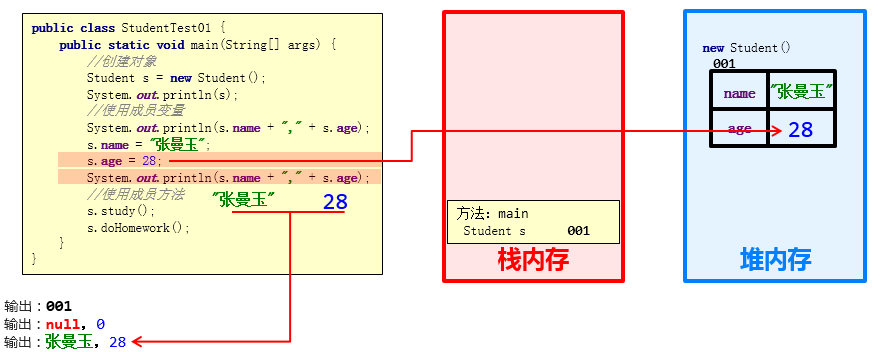
- 成员方法调用过程
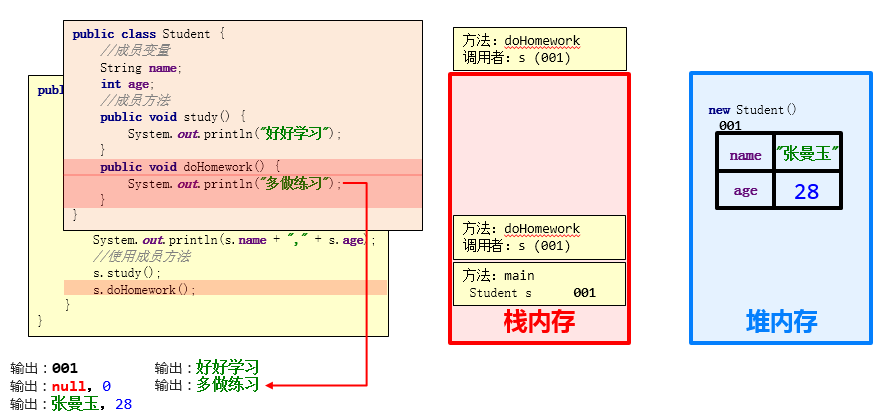
8.2.2 多个对象内存图
- 成员变量使用过程
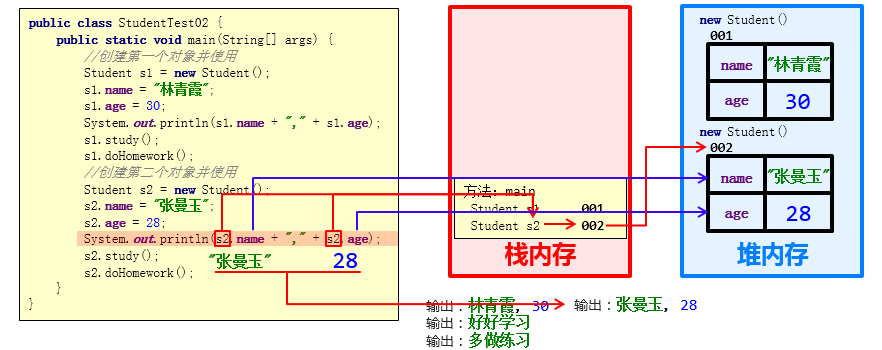
- 成员方法调用过程
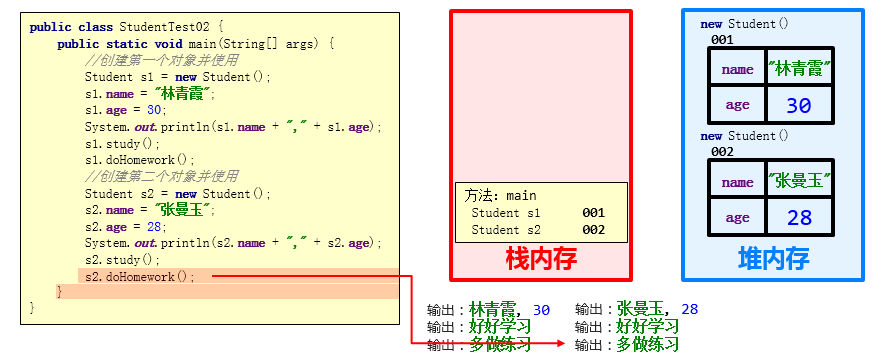
-
总结:
多个对象在堆内存中,都有不同的内存划分,成员变量存储在各自的内存区域中,成员方法多个对象共用的一份
8.3. 成员变量和局部变量
8.3.1 成员变量和局部变量的区别
- 类中位置不同:成员变量(类中方法外)局部变量(方法内部或方法声明上)
- 内存中位置不同:成员变量(堆内存)局部变量(栈内存)
- 生命周期不同:成员变量(随着对象的存在而存在,随着对象的消失而消失)局部变量(随着方法的调用而存在,醉着方法的调用完毕而消失)
- 初始化值不同:成员变量(有默认初始化值)局部变量(没有默认初始化值,必须先定义,赋值才能使用)
8.4. 封装
8.4.1 封装思想
-
封装概述
是面向对象三大特征之一(封装,继承,多态)对象代表什么,就得封装对应的数据,并提供数据对应的行为
-
封装代码实现
将类的某些信息隐藏在类内部,不允许外部程序直接访问,而是通过该类提供的方法来实现对隐藏信息的操作和访问
成员变量private,提供对应的getXxx()/setXxx()方法
8.4.2 private关键字
private是一个修饰符,可以用来修饰成员(成员变量,成员方法)
-
被private修饰的成员,只能在本类进行访问,针对private修饰的成员变量,如果需要被其他类使用,提供相应的操作
- 提供“get变量名()”方法,用于获取成员变量的值,方法用public修饰
- 提供“set变量名(参数)”方法,用于设置成员变量的值,方法用public修饰
-
示例代码:
/* 学生类 */ class Student { //成员变量 String name; private int age; //提供get/set方法 public void setAge(int a) { if(a<0 || a>120) { System.out.println("你给的年龄有误"); } else { age = a; } } public int getAge() { return age; } //成员方法 public void show() { System.out.println(name + "," + age); } } /* 学生测试类 */ public class StudentDemo { public static void main(String[] args) { //创建对象 Student s = new Student(); //给成员变量赋值 s.name = "林青霞"; s.setAge(30); //调用show方法 s.show(); } }
8.4.3 private的使用
-
需求:定义标准的学生类,要求name和age使用private修饰,并提供set和get方法以及便于显示数据的show方法,测试类中创建对象并使用,最终控制台输出 林青霞,30
-
示例代码:
/* 学生类 */ class Student { //成员变量 private String name; private int age; //get/set方法 public void setName(String n) { name = n; } public String getName() { return name; } public void setAge(int a) { age = a; } public int getAge() { return age; } public void show() { System.out.println(name + "," + age); } } /* 学生测试类 */ public class StudentDemo { public static void main(String[] args) { //创建对象 Student s = new Student(); //使用set方法给成员变量赋值 s.setName("林青霞"); s.setAge(30); s.show(); //使用get方法获取成员变量的值 System.out.println(s.getName() + "---" + s.getAge()); System.out.println(s.getName() + "," + s.getAge()); } }
8.4.4 this关键字
- this修饰的变量用于指代成员变量,其主要作用是(区分局部变量和成员变量的重名问题)
- 方法的形参如果与成员变量同名,不带this修饰的变量指的是形参,而不是成员变量
- 方法的形参没有与成员变量同名,不带this修饰的变量指的是成员变量
public class Student {
private String name;
private int age;
public void setName(String name) {
this.name = name;
}
public String getName() {
return name;
}
public void setAge(int age) {
this.age = age;
}
public int getAge() {
return age;
}
public void show() {
System.out.println(name + "," + age);
}
}
8.5. 构造方法
8.5.1 构造方法概述
构造方法是一种特殊的方法
-
作用:创建对象 Student stu = new Student();
-
格式:
public class 类名{
修饰符 类名( 参数 ) {
}
}
-
功能:主要是完成对象数据的初始化
-
示例代码:
class Student {
private String name;
private int age;
//构造方法
public Student() {
System.out.println("无参构造方法");
}
public void show() {
System.out.println(name + "," + age);
}
}
/*
测试类
*/
public class StudentDemo {
public static void main(String[] args) {
//创建对象
Student s = new Student();
s.show();
}
}
8.5.2 构造方法的注意事项
- 构造方法的创建
如果没有定义构造方法,系统将给出一个默认的无参数构造方法
如果定义了构造方法,系统将不再提供默认的构造方法
- 构造方法的重载
如果自定义了带参构造方法,还要使用无参数构造方法,就必须再写一个无参数构造方法
- 推荐的使用方式
无论是否使用,都手工书写无参数构造方法
- 重要功能!
可以使用带参构造,为成员变量进行初始化
- 示例代码
/*
学生类
*/
class Student {
private String name;
private int age;
public Student() {}
public Student(String name) {
this.name = name;
}
public Student(int age) {
this.age = age;
}
public Student(String name,int age) {
this.name = name;
this.age = age;
}
public void show() {
System.out.println(name + "," + age);
}
}
/*
测试类
*/
public class StudentDemo {
public static void main(String[] args) {
//创建对象
Student s1 = new Student();
s1.show();
//public Student(String name)
Student s2 = new Student("林青霞");
s2.show();
//public Student(int age)
Student s3 = new Student(30);
s3.show();
//public Student(String name,int age)
Student s4 = new Student("林青霞",30);
s4.show();
}
}
8.5.3 标准类制作
① 类名需要见名知意
② 成员变量使用private修饰
③ 提供至少两个构造方法
- 无参构造方法
- 带全部参数的构造方法
④ get和set方法
提供每一个成员变量对应的setXxx()/getXxx()
⑤ 如果还有其他行为,也需要写上
8.5.4 练习1
需求:
定义标准学生类,要求分别使用空参和有参构造方法创建对象,空参创建的对象通过setXxx赋值,有参创建的对象直接赋值,并通过show方法展示数据。
- 示例代码:
class Student {
//成员变量
private String name;
private int age;
//构造方法
public Student() {
}
public Student(String name, int age) {
this.name = name;
this.age = age;
}
//成员方法
public void setName(String name) {
this.name = name;
}
public String getName() {
return name;
}
public void setAge(int age) {
this.age = age;
}
public int getAge() {
return age;
}
public void show() {
System.out.println(name + "," + age);
}
}
/*
创建对象并为其成员变量赋值的两种方式
1:无参构造方法创建对象后使用setXxx()赋值
2:使用带参构造方法直接创建带有属性值的对象
*/
public class StudentDemo {
public static void main(String[] args) {
//无参构造方法创建对象后使用setXxx()赋值
Student s1 = new Student();
s1.setName("林青霞");
s1.setAge(30);
s1.show();
//使用带参构造方法直接创建带有属性值的对象
Student s2 = new Student("林青霞",30);
s2.show();
}
}
8.5.4 练习2

public class User {
//1.私有化全部的成员变量
//2.空参构造
//3.带全部参数的构造
//4.针对于每一个私有化的成员变量都要提供其对应的get和set方法
//5.如果当前事物还有其他行为,那么也要写出来,比如学生的吃饭,睡觉等行为
private String username;//用户名
private String password;//密码
private String email;//邮箱
private char gender;//性别
private int age;//年龄
//空参构造方法
public User() {
}
//带全部参数的构造
public User(String username, String password, String email, char gender, int age) {
this.username = username;
this.password = password;
this.email = email;
this.gender = gender;
this.age = age;
}
//get和set
public String getUsername() {
return username;
}
public void setUsername(String username) {
this.username = username;
}
public String getPassword() {
return password;
}
public void setPassword(String password) {
this.password = password;
}
public String getEmail() {
return email;
}
public void setEmail(String email) {
this.email = email;
}
public char getGender() {
return gender;
}
public void setGender(char gender) {
this.gender = gender;
}
public int getAge() {
return age;
}
public void setAge(int age) {
this.age = age;
}
public void eat(){
System.out.println(username + "在吃饭");
}
}
public class Test {
public static void main(String[] args) {
//写一个标准的javabean类
//咱们在课后只要能把这个标准的javabean能自己写出来,那么就表示今天的知识点就ok了
//利用空参构造创建对象
User u1 = new User();
//如果利用空参创建对象,还想赋值只能用set方法赋值
u1.setUsername("zhangsan");
u1.setPassword("1234qwer");
u1.setEmail("itheima@itcast.cn");
u1.setGender('男');
u1.setAge(23);
//获取属性的值并打印
System.out.println(u1.getUsername() + ", " + u1.getPassword()
+ ", " + u1.getEmail() + ", " + u1.getGender() + ", " + u1.getAge());
u1.eat();
System.out.println("=============================");
//简单的办法
//利用带全部参数的构造来创建对象
//快捷键:ctrl + p
User u2 = new User("lisi","12345678","lisi@itcast.cn",'女',24);
System.out.println(u2.getUsername() + ", " + u2.getPassword()
+ ", " + u2.getEmail() + ", " + u2.getGender() + ", " + u2.getAge());
u2.eat();
}
}
9、面向对象综合训练
扩展:键盘录入笔记
一,键盘录入涉及到的方法如下:
next()、nextLine()、nextInt()、nextDouble()。
1)next()、nextLine():
可以接受任意数据,但是都会返回一个字符串。
比如:键盘录入abc,那么会把abc看做字符串返回。
键盘录入123,那么会把123看做字符串返回。
代码示例:
Scanner sc = new Scanner(System.in);
String s = sc.next();//录入的所有数据都会看做是字符串
System.out.println(s);
代码示例:
Scanner sc = new Scanner(System.in);
String s = sc.nextLine();//录入的所有数据都会看做是字符串
System.out.println(s);
2)nextInt():
只能接受整数。
比如:键盘录入123,那么会把123当做int类型的整数返回。
键盘录入小数或者其他字母,就会报错。
代码示例:
Scanner sc = new Scanner(System.in);
int s = sc.nextInt();//只能录入整数
System.out.println(s);
3)nextDouble():
能接收整数和小数,但是都会看做小数返回。
录入字母会报错。
代码示例:
Scanner sc = new Scanner(System.in);
double d = sc.nextDouble();//录入的整数,小数都会看做小数。
//录入字母会报错
System.out.println(d);
二,方法底层细节 :
第一个细节:
next(),nextInt(),nextDouble()在接收数据的时候,会遇到空格,回车,制表符其中一个就会停止接收数据。
代码示例:
Scanner sc = new Scanner(System.in);
double d = sc.nextDouble();
System.out.println(d);
//键盘录入:1.1 2.2//注意录入的时候1.1和2.2之间加空格隔开。
//此时控制台打印1.1
//表示nextDouble方法在接收数据的时候,遇到空格就停止了,后面的本次不接收。
Scanner sc = new Scanner(System.in);
int i = sc.nextInt();
System.out.println(i);
//键盘录入:1 2//注意录入的时候1和2之间加空格隔开。
//此时控制台打印1
//表示nextInt方法在接收数据的时候,遇到空格就停止了,后面的本次不接收。
Scanner sc = new Scanner(System.in);
String s = sc.next();
System.out.println(s);
//键盘录入:a b//注意录入的时候a和b之间加空格隔开。
//此时控制台打印a
//表示next方法在接收数据的时候,遇到空格就停止了,后面的本次不接收。
第二个细节:
next(),nextInt(),nextDouble()在接收数据的时候,会遇到空格,回车,制表符其中一个就会停止接收数据。但是这些符号 + 后面的数据还在内存中并没有接收。如果后面还有其他键盘录入的方法,会自动将这些数据接收。
代码示例:
Scanner sc = new Scanner(System.in);
String s1 = sc.next();
String s2 = sc.next();
System.out.println(s1);
System.out.println(s2);
//此时值键盘录入一次a b(注意a和b之间用空格隔开)
//那么第一个next();会接收a,a后面是空格,那么就停止,所以打印s1是a
//但是空格+b还在内存中。
//第二个next会去掉前面的空格,只接收b
//所以第二个s2打印出来是b
第三个细节:
nextLine()方法是把一整行全部接收完毕。
代码示例:
Scanner sc = new Scanner(System.in);
String s = sc.nextLine();
System.out.println(s);
//键盘录入a b(注意a和b之间用空格隔开)
//那么nextLine不会过滤前面和后面的空格,会把这一整行数据全部接收完毕。
三、混用引起的后果
上面说的两套键盘录入不能混用,如果混用会有严重的后果。
代码示例:
Scanner sc = new Scanner(System.in);//①
int i = sc.nextInt();//②
String s = sc.nextLine();//③
System.out.println(i);//④
System.out.println(s);//⑤
当代码运行到第二行,会让我们键盘录入,此时录入123。
但是实际上我们录的是123+回车。
而nextInt是遇到空格,回车,制表符都会停止。
所以nextInt只能接受123,回车还在内存中没有被接收。
此时就被nextLine接收了。
所以,如果混用就会导致nextLine接收不到数据。
四、结论(如何使用)
键盘录入分为两套:
- next()、nextInt()、nextDouble()这三个配套使用。
如果用了这三个其中一个,就不要用nextLine()。
- nextLine()单独使用。
如果想要整数,那么先接收,再使用Integer.parseInt进行类型转换。
代码示例:
Scanner sc = new Scanner(System.in);
String s = sc.next();//键盘录入123
System.out.println("此时为字符串" + s);//此时123是字符串
int i = sc.nextInt();//键盘录入123
System.out.println("此时为整数:" + i);
Scanner sc = new Scanner(System.in);
String s = sc.nextLine();//键盘录入123
System.out.println("此时为字符串" + s);//此时123是字符串
int i = Integer.parseInt(s);//想要整数再进行转换
System.out.println("此时为整数:" + i);
练习一:文字版格斗游戏
需求:
格斗游戏,每个游戏角色的姓名,血量,都不相同,在选定人物的时候(new对象的时候),这些信息就应该被确定下来。
举例:
程序运行之后结果为:
姓名为:乔峰 血量为:100
姓名为:鸠摩智 血量为:100
乔峰举起拳头打了鸠摩智一下,造成了XX点伤害,鸠摩智还剩下XXX点血。
鸠摩智举起拳头打了鸠摩智一下,造成了XX点伤害,乔峰还剩下XXX点血。
乔峰举起拳头打了鸠摩智一下,造成了XX点伤害,鸠摩智还剩下XXX点血。
鸠摩智举起拳头打了鸠摩智一下,造成了XX点伤害,乔峰还剩下XXX点血。
乔峰K.O.了鸠摩智
代码示例:
public class GameTest {
public static void main(String[] args) {
//1.创建第一个角色
Role r1 = new Role("乔峰",100);
//2.创建第二个角色
Role r2 = new Role("鸠摩智",100);
//3.开始格斗 回合制游戏
while(true){
//r1开始攻击r2
r1.attack(r2);
//判断r2的剩余血量
if(r2.getBlood() == 0){
System.out.println(r1.getName() + " K.O了" + r2.getName());
break;
}
//r2开始攻击r1
r2.attack(r1);
if(r1.getBlood() == 0){
System.out.println(r2.getName() + " K.O了" + r1.getName());
break;
}
}
}
}
public class Role {
private String name;
private int blood;
public Role() {
}
public Role(String name, int blood) {
this.name = name;
this.blood = blood;
}
public String getName() {
return name;
}
public void setName(String name) {
this.name = name;
}
public int getBlood() {
return blood;
}
public void setBlood(int blood) {
this.blood = blood;
}
//定义一个方法用于攻击别人
//思考:谁攻击谁?
//Role r1 = new Role();
//Role r2 = new Role();
//r1.攻击(r2);
//方法的调用者去攻击参数
public void attack(Role role) {
//计算造成的伤害 1 ~ 20
Random r = new Random();
int hurt = r.nextInt(20) + 1;
//剩余血量
int remainBoold = role.getBlood() - hurt;
//对剩余血量做一个验证,如果为负数了,就修改为0
remainBoold = remainBoold < 0 ? 0 : remainBoold;
//修改一下挨揍的人的血量
role.setBlood(remainBoold);
//this表示方法的调用者
System.out.println(this.getName() + "举起拳头,打了" + role.getName() + "一下," +
"造成了" + hurt + "点伤害," + role.getName() + "还剩下了" + remainBoold + "点血");
}
}
练习二:文字版格斗游戏进阶
在上一个的基础上,我想看到人物的性别和长相,打斗的时候我想看到武功招式。
举例:
程序运行之后结果为:
姓名为:乔峰 血量为:100 性别为:男 长相为:气宇轩昂
姓名为:鸠摩智 血量为:100 性别为:男 长相为:气宇轩昂
乔峰使出了一招【背心钉】,转到对方的身后,一掌向鸠摩智背心的灵台穴拍去。给鸠摩智造成一处瘀伤。
鸠摩智使出了一招【游空探爪】,飞起身形自半空中变掌为抓锁向乔峰。结果乔峰退了半步,毫发无损。
。。。。
乔峰K.O.了鸠摩智
分析:
长相是提前定义好的,提前放在一个数组当中,程序运行之后,从数组中随机获取。
//男生长相数组
String[] boyfaces = {"风流俊雅", "气宇轩昂", "相貌英俊", "五官端正", "相貌平平", "一塌糊涂", "面目狰狞"};
//女生长相数组
String[] girlfaces = {"美奂绝伦", "沉鱼落雁", "婷婷玉立", "身材娇好", "相貌平平", "相貌简陋", "惨不忍睹"};
武功招式也是提前定义好的,提前放在一个数组当中,程序运行之后,从数组随机获取
//attack 攻击描述:
String[] attacks_desc = {
"%s使出了一招【背心钉】,转到对方的身后,一掌向%s背心的灵台穴拍去。",
"%s使出了一招【游空探爪】,飞起身形自半空中变掌为抓锁向%s。",
"%s大喝一声,身形下伏,一招【劈雷坠地】,捶向%s双腿。",
"%s运气于掌,一瞬间掌心变得血红,一式【掌心雷】,推向%s。",
"%s阴手翻起阳手跟进,一招【没遮拦】,结结实实的捶向%s。",
"%s上步抢身,招中套招,一招【劈挂连环】,连环攻向%s。"
受伤的提前也是提前定义好的,只不过不是随机了,根据剩余血量获取不同的描述
//injured 受伤描述:
String[] injureds_desc = {
"结果%s退了半步,毫发无损",
"结果给%s造成一处瘀伤",
"结果一击命中,%s痛得弯下腰",
"结果%s痛苦地闷哼了一声,显然受了点内伤",
"结果%s摇摇晃晃,一跤摔倒在地",
"结果%s脸色一下变得惨白,连退了好几步",
"结果『轰』的一声,%s口中鲜血狂喷而出",
"结果%s一声惨叫,像滩软泥般塌了下去"
其中输出语句跟以前不一样了,用的是System.out.printf();该输出语句支持%s占位符
public class Test {
public static void main(String[] args) {
//两部分参数:
//第一部分参数:要输出的内容%s(占位)
//第二部分参数:填充的数据
System.out.printf("你好啊%s","张三");//用张三填充第一个%s
System.out.println();//换行
System.out.printf("%s你好啊%s","张三","李四");//用张三填充第一个%s,李四填充第二个%s
}
}
最终代码示例:
package com.itheima.test2;
import java.util.Random;
public class Role {
private String name;
private int blood;
private char gender;
private String face;//长相是随机的
String[] boyfaces = {"风流俊雅", "气宇轩昂", "相貌英俊", "五官端正", "相貌平平", "一塌糊涂", "面目狰狞"};
String[] girlfaces = {"美奂绝伦", "沉鱼落雁", "婷婷玉立", "身材娇好", "相貌平平", "相貌简陋", "惨不忍睹"};
//attack 攻击描述:
String[] attacks_desc = {
"%s使出了一招【背心钉】,转到对方的身后,一掌向%s背心的灵台穴拍去。",
"%s使出了一招【游空探爪】,飞起身形自半空中变掌为抓锁向%s。",
"%s大喝一声,身形下伏,一招【劈雷坠地】,捶向%s双腿。",
"%s运气于掌,一瞬间掌心变得血红,一式【掌心雷】,推向%s。",
"%s阴手翻起阳手跟进,一招【没遮拦】,结结实实的捶向%s。",
"%s上步抢身,招中套招,一招【劈挂连环】,连环攻向%s。"
};
//injured 受伤描述:
String[] injureds_desc = {
"结果%s退了半步,毫发无损",
"结果给%s造成一处瘀伤",
"结果一击命中,%s痛得弯下腰",
"结果%s痛苦地闷哼了一声,显然受了点内伤",
"结果%s摇摇晃晃,一跤摔倒在地",
"结果%s脸色一下变得惨白,连退了好几步",
"结果『轰』的一声,%s口中鲜血狂喷而出",
"结果%s一声惨叫,像滩软泥般塌了下去"
};
public Role() {
}
public Role(String name, int blood, char gender) {
this.name = name;
this.blood = blood;
this.gender = gender;
//随机长相
setFace(gender);
}
public char getGender() {
return gender;
}
public void setGender(char gender) {
this.gender = gender;
}
public String getFace() {
return face;
}
public void setFace(char gender) {
Random r = new Random();
//长相是随机的
if (gender == '男') {
//从boyfaces里面随机长相
int index = r.nextInt(boyfaces.length);
this.face = boyfaces[index];
} else if (gender == '女') {
//从girlfaces里面随机长相
int index = r.nextInt(girlfaces.length);
this.face = girlfaces[index];
} else {
this.face = "面目狰狞";
}
}
public String getName() {
return name;
}
public void setName(String name) {
this.name = name;
}
public int getBlood() {
return blood;
}
public void setBlood(int blood) {
this.blood = blood;
}
//定义一个方法用于攻击别人
//思考:谁攻击谁?
//Role r1 = new Role();
//Role r2 = new Role();
//r1.攻击(r2);
//方法的调用者去攻击参数
public void attack(Role role) {
Random r = new Random();
int index = r.nextInt(attacks_desc.length);
String KungFu = attacks_desc[index];
//输出一个攻击的效果
System.out.printf(KungFu, this.getName(), role.getName());
System.out.println();
//计算造成的伤害 1 ~ 20
int hurt = r.nextInt(20) + 1;
//剩余血量
int remainBoold = role.getBlood() - hurt;
//对剩余血量做一个验证,如果为负数了,就修改为0
remainBoold = remainBoold < 0 ? 0 : remainBoold;
//修改一下挨揍的人的血量
role.setBlood(remainBoold);
//受伤的描述
//血量> 90 0索引的描述
//80 ~ 90 1索引的描述
//70 ~ 80 2索引的描述
//60 ~ 70 3索引的描述
//40 ~ 60 4索引的描述
//20 ~ 40 5索引的描述
//10 ~ 20 6索引的描述
//小于10的 7索引的描述
if (remainBoold > 90) {
System.out.printf(injureds_desc[0], role.getName());
}else if(remainBoold > 80 && remainBoold <= 90){
System.out.printf(injureds_desc[1], role.getName());
}else if(remainBoold > 70 && remainBoold <= 80){
System.out.printf(injureds_desc[2], role.getName());
}else if(remainBoold > 60 && remainBoold <= 70){
System.out.printf(injureds_desc[3], role.getName());
}else if(remainBoold > 40 && remainBoold <= 60){
System.out.printf(injureds_desc[4], role.getName());
}else if(remainBoold > 20 && remainBoold <= 40){
System.out.printf(injureds_desc[5], role.getName());
}else if(remainBoold > 10 && remainBoold <= 20){
System.out.printf(injureds_desc[6], role.getName());
}else{
System.out.printf(injureds_desc[7], role.getName());
}
System.out.println();
}
public void showRoleInfo() {
System.out.println("姓名为:" + getName());
System.out.println("血量为:" + getBlood());
System.out.println("性别为:" + getGender());
System.out.println("长相为:" + getFace());
}
}
package com.itheima.test2;
public class GameTest {
public static void main(String[] args) {
//1.创建第一个角色
Role r1 = new Role("乔峰",100,'男');
//2.创建第二个角色
Role r2 = new Role("鸠摩智",100,'男');
//展示一下角色的信息
r1.showRoleInfo();
r2.showRoleInfo();
//3.开始格斗 回合制游戏
while(true){
//r1开始攻击r2
r1.attack(r2);
//判断r2的剩余血量
if(r2.getBlood() == 0){
System.out.println(r1.getName() + " K.O了" + r2.getName());
break;
}
//r2开始攻击r1
r2.attack(r1);
if(r1.getBlood() == 0){
System.out.println(r2.getName() + " K.O了" + r1.getName());
break;
}
}
}
}
练习三:对象数组(商品)
需求:
定义数组存储3个商品对象。
商品的属性:商品的id,名字,价格,库存。
创建三个商品对象,并把商品对象存入到数组当中。
代码示例:
package com.itheima.test3;
public class Goods {
private String id;
private String name;
private double price;
private int count;
public Goods() {
}
public Goods(String id, String name, double price, int count) {
this.id = id;
this.name = name;
this.price = price;
this.count = count;
}
public String getId() {
return id;
}
public void setId(String id) {
this.id = id;
}
public String getName() {
return name;
}
public void setName(String name) {
this.name = name;
}
public double getPrice() {
return price;
}
public void setPrice(double price) {
this.price = price;
}
public int getCount() {
return count;
}
public void setCount(int count) {
this.count = count;
}
}
package com.itheima.test3;
public class GoodsTest {
public static void main(String[] args) {
//1.创建一个数组
Goods[] arr = new Goods[3];
//2.创建三个商品对象
Goods g1 = new Goods("001","华为P40",5999.0,100);
Goods g2 = new Goods("002","保温杯",227.0,50);
Goods g3 = new Goods("003","枸杞",12.7,70);
//3.把商品添加到数组中
arr[0] = g1;
arr[1] = g2;
arr[2] = g3;
//4.遍历
for (int i = 0; i < arr.length; i++) {
//i 索引 arr[i] 元素
Goods goods = arr[i];
System.out.println(goods.getId() + ", " + goods.getName() + ", " + goods.getPrice() + ", " + goods.getCount());
}
}
}
练习四:对象数组(汽车)
需求:
定义数组存储3部汽车对象。
汽车的属性:品牌,价格,颜色。
创建三个汽车对象,数据通过键盘录入而来,并把数据存入到数组当中。
代码示例:
package com.itheima.test5;
public class Car {
private String brand;//品牌
private int price;//价格
private String color;//颜色
public Car() {
}
public Car(String brand, int price, String color) {
this.brand = brand;
this.price = price;
this.color = color;
}
public String getBrand() {
return brand;
}
public void setBrand(String brand) {
this.brand = brand;
}
public int getPrice() {
return price;
}
public void setPrice(int price) {
this.price = price;
}
public String getColor() {
return color;
}
public void setColor(String color) {
this.color = color;
}
}
package com.itheima.test5;
import java.util.Scanner;
public class CarTest {
public static void main(String[] args) {
//1.创建一个数组用来存3个汽车对象
Car[] arr = new Car[3];
//2.创建汽车对象,数据来自于键盘录入
Scanner sc = new Scanner(System.in);
for (int i = 0; i < arr.length; i++) {
//创建汽车的对象
Car c = new Car();
//录入品牌
System.out.println("请输入汽车的品牌");
String brand = sc.next();
c.setBrand(brand);
//录入价格
System.out.println("请输入汽车的价格");
int price = sc.nextInt();
c.setPrice(price);
//录入颜色
System.out.println("请输入汽车的颜色");
String color = sc.next();
c.setColor(color);
//把汽车对象添加到数组当中
arr[i] = c;
}
//3.遍历数组
for (int i = 0; i < arr.length; i++) {
Car car = arr[i];
System.out.println(car.getBrand() + ", " + car.getPrice() + ", " + car.getColor());
}
}
}
练习五:对象数组(手机)
需求 :
定义数组存储3部手机对象。
手机的属性:品牌,价格,颜色。
要求,计算出三部手机的平均价格
代码示例:
package com.itheima.test6;
public class Phone {
private String brand;//品牌
private int price;//价格
private String color;//颜色
public Phone() {
}
public Phone(String brand, int price, String color) {
this.brand = brand;
this.price = price;
this.color = color;
}
public String getBrand() {
return brand;
}
public void setBrand(String brand) {
this.brand = brand;
}
public int getPrice() {
return price;
}
public void setPrice(int price) {
this.price = price;
}
public String getColor() {
return color;
}
public void setColor(String color) {
this.color = color;
}
}
package com.itheima.test6;
import java.math.BigDecimal;
public class PhoneTest {
public static void main(String[] args) {
//1.创建一个数组
Phone[] arr = new Phone[3];
//2.创建手机的对象
Phone p1 = new Phone("小米",1999,"白色");
Phone p2 = new Phone("华为",4999,"蓝色");
Phone p3 = new Phone("魅族",3999,"红色");
//3.把手机对象添加到数组当中
arr[0] = p1;
arr[1] = p2;
arr[2] = p3;
//4.获取三部手机的平均价格
int sum = 0;
for (int i = 0; i < arr.length; i++) {
//i 索引 arr[i] 元素(手机对象)
Phone phone = arr[i];
sum = sum + phone.getPrice();
}
//5.求平均值
//数据能不写死,尽量不写死
//int avg = sum / arr.length;
double avg2 = sum * 1.0 / arr.length;
System.out.println(avg2);//3665.6666666666665
}
}
练习六:对象数组(女朋友)
需求:
定义数组存储4个女朋友的对象
女朋友的属性:姓名、年龄、性别、爱好
要求1:计算出四女朋友的平均年龄
要求2:统计年龄比平均值低的女朋友有几个?并把她们的所有信息打印出来。
代码示例:
package com.itheima.test7;
public class GirlFriend {
private String name;//姓名
private int age;//年龄
private String gender;//性别
private String hobby;//爱好
public GirlFriend() {
}
public GirlFriend(String name, int age, String gender, String hobby) {
this.name = name;
this.age = age;
this.gender = gender;
this.hobby = hobby;
}
public String getName() {
return name;
}
public void setName(String name) {
this.name = name;
}
public int getAge() {
return age;
}
public void setAge(int age) {
this.age = age;
}
public String getGender() {
return gender;
}
public void setGender(String gender) {
this.gender = gender;
}
public String getHobby() {
return hobby;
}
public void setHobby(String hobby) {
this.hobby = hobby;
}
}
package com.itheima.test7;
public class GirlFriendTest {
public static void main(String[] args) {
//1.定义数组存入女朋友的对象
GirlFriend[] arr = new GirlFriend[4];
//2.创建女朋友对象
GirlFriend gf1 = new GirlFriend("小诗诗",18,"萌妹子","吃零食");
GirlFriend gf2 = new GirlFriend("小丹丹",19,"萌妹子","玩游戏");
GirlFriend gf3 = new GirlFriend("小惠惠",20,"萌妹子","看书,学习");
GirlFriend gf4 = new GirlFriend("小莉莉",21,"憨妹子","睡觉");
//3.把对象添加到数组当中
arr[0] = gf1;
arr[1] = gf2;
arr[2] = gf3;
arr[3] = gf4;
//4.求和
int sum = 0;
for (int i = 0; i < arr.length; i++) {
//i 索引 arr[i] 元素(女朋友对象)
GirlFriend gf = arr[i];
//累加
sum = sum + gf.getAge();
}
//5.平均值
int avg = sum / arr.length;
//6.统计年龄比平均值低的有几个,打印他们的信息
int count = 0;
for (int i = 0; i < arr.length; i++) {
GirlFriend gf = arr[i];
if(gf.getAge() < avg){
count++;
System.out.println(gf.getName() + ", " + gf.getAge() + ", " + gf.getGender() + ", " + gf.getHobby());
}
}
System.out.println(count + "个");
}
}
练习七:复杂的对象数组操作
定义一个长度为3的数组,数组存储1~3名学生对象作为初始数据,学生对象的学号,姓名各不相同。
学生的属性:学号,姓名,年龄。
要求1:再次添加一个学生对象,并在添加的时候进行学号的唯一性判断。
要求2:添加完毕之后,遍历所有学生信息。
要求3:通过id删除学生信息
如果存在,则删除,如果不存在,则提示删除失败。
要求4:删除完毕之后,遍历所有学生信息。
要求5:查询数组id为“heima002”的学生,如果存在,则将他的年龄+1岁
代码示例:
package com.itheima.test8;
public class Student {
private int id;
private String name;
private int age;
public Student() {
}
public Student(int id, String name, int age) {
this.id = id;
this.name = name;
this.age = age;
}
public int getId() {
return id;
}
public void setId(int id) {
this.id = id;
}
public String getName() {
return name;
}
public void setName(String name) {
this.name = name;
}
public int getAge() {
return age;
}
public void setAge(int age) {
this.age = age;
}
}
public class Test {
public static void main(String[] args) {
/*定义一个长度为3的数组,数组存储1~3名学生对象作为初始数据,学生对象的学号,姓名各不相同。
学生的属性:学号,姓名,年龄。
要求1:再次添加一个学生对象,并在添加的时候进行学号的唯一性判断。
要求2:添加完毕之后,遍历所有学生信息。
*/
//1.创建一个数组用来存储学生对象
Student[] arr = new Student[3];
//2.创建学生对象并添加到数组当中
Student stu1 = new Student(1, "zhangsan", 23);
Student stu2 = new Student(2, "lisi", 24);
//3.把学生对象添加到数组当中
arr[0] = stu1;
arr[1] = stu2;
//要求1:再次添加一个学生对象,并在添加的时候进行学号的唯一性判断。
Student stu4 = new Student(1, "zhaoliu", 26);
//唯一性判断
//已存在 --- 不用添加
//不存在 --- 就可以把学生对象添加进数组
boolean flag = contains(arr, stu4.getId());
if(flag){
//已存在 --- 不用添加
System.out.println("当前id重复,请修改id后再进行添加");
}else{
//不存在 --- 就可以把学生对象添加进数组
//把stu4添加到数组当中
//1.数组已经存满 --- 只能创建一个新的数组,新数组的长度 = 老数组 + 1
//2.数组没有存满 --- 直接添加
int count = getCount(arr);
if(count == arr.length){
//已经存满
//创建一个新的数组,长度 = 老数组的长度 + 1
//然后把老数组的元素,拷贝到新数组当中
Student[] newArr = creatNewArr(arr);
//把stu4添加进去
newArr[count] = stu4;
//要求2:添加完毕之后,遍历所有学生信息。
printArr(newArr);
}else{
//没有存满
//[stu1,stu2,null]
//getCount获取到的是2,表示数组当中已经有了2个元素
//还有一层意思:如果下一次要添加数据,就是添加到2索引的位置
arr[count] = stu4;
//要求2:添加完毕之后,遍历所有学生信息。
printArr(arr);
}
}
}
public static void printArr(Student[] arr){
for (int i = 0; i < arr.length; i++) {
Student stu = arr[i];
if(stu != null){
System.out.println(stu.getId() + ", " + stu.getName() + ", " + stu.getAge());
}
}
}
//创建一个新的数组,长度 = 老数组的长度 + 1
//然后把老数组的元素,拷贝到新数组当中
public static Student[] creatNewArr(Student[] arr){
Student[] newArr = new Student[arr.length + 1];
//循环遍历得到老数组中的每一个元素
for (int i = 0; i < arr.length; i++) {
//把老数组中的元素添加到新数组当中
newArr[i] = arr[i];
}
//把新数组返回
return newArr;
}
//定义一个方法判断数组中已经存了几个元素
public static int getCount(Student[] arr){
//定义一个计数器用来统计
int count = 0;
for (int i = 0; i < arr.length; i++) {
if(arr[i] != null){
count++;
}
}
//当循环结束之后,我就知道了数组中一共有几个元素
return count;
}
//1.我要干嘛? 唯一性判断
//2.我干这件事情,需要什么才能完成? 数组 id
//3.调用处是否需要继续使用方法的结果? 必须返回
public static boolean contains(Student[] arr, int id) {
for (int i = 0; i < arr.length; i++) {
//依次获取到数组里面的每一个学生对象
Student stu = arr[i];
if(stu != null){
//获取数组中学生对象的id
int sid = stu.getId();
//比较
if(sid == id){
return true;
}
}
}
//当循环结束之后,还没有找到一样的,那么就表示数组中要查找的id是不存在的。
return false;
}
}
package com.itheima.test8;
public class Test3 {
public static void main(String[] args) {
/*定义一个长度为3的数组,数组存储1~3名学生对象作为初始数据,学生对象的学号,姓名各不相同。
学生的属性:学号,姓名,年龄。
要求3:通过id删除学生信息
如果存在,则删除,如果不存在,则提示删除失败。
要求4:删除完毕之后,遍历所有学生信息。
*/
//1.创建一个数组用来存储学生对象
Student[] arr = new Student[3];
//2.创建学生对象并添加到数组当中
Student stu1 = new Student(1, "zhangsan", 23);
Student stu2 = new Student(2, "lisi", 24);
Student stu3 = new Student(3, "wangwu", 25);
//3.把学生对象添加到数组当中
arr[0] = stu1;
arr[1] = stu2;
arr[2] = stu3;
/*要求3:通过id删除学生信息
如果存在,则删除,如果不存在,则提示删除失败。*/
//要找到id在数组中对应的索引
int index = getIndex(arr, 2);
if (index >= 0){
//如果存在,则删除
arr[index] = null;
//遍历数组
printArr(arr);
}else{
//如果不存在,则提示删除失败
System.out.println("当前id不存在,删除失败");
}
}
//1.我要干嘛? 找到id在数组中的索引
//2.我需要什么? 数组 id
//3.调用处是否需要继续使用方法的结果? 要
public static int getIndex(Student[] arr , int id){
for (int i = 0; i < arr.length; i++) {
//依次得到每一个学生对象
Student stu = arr[i];
//对stu进行一个非空判断
if(stu != null){
int sid = stu.getId();
if(sid == id){
return i;
}
}
}
//当循环结束之后,还没有找到就表示不存在
return -1;
}
public static void printArr(Student[] arr){
for (int i = 0; i < arr.length; i++) {
Student stu = arr[i];
if(stu != null){
System.out.println(stu.getId() + ", " + stu.getName() + ", " + stu.getAge());
}
}
}
}
package com.itheima.test8;
public class Test4 {
public static void main(String[] args) {
/*定义一个长度为3的数组,数组存储1~3名学生对象作为初始数据,学生对象的学号,姓名各不相同。
学生的属性:学号,姓名,年龄。
要求5:查询数组id为“2”的学生,如果存在,则将他的年龄+1岁*/
//1.创建一个数组用来存储学生对象
Student[] arr = new Student[3];
//2.创建学生对象并添加到数组当中
Student stu1 = new Student(1, "zhangsan", 23);
Student stu2 = new Student(2, "lisi", 24);
Student stu3 = new Student(3, "wangwu", 25);
//3.把学生对象添加到数组当中
arr[0] = stu1;
arr[1] = stu2;
arr[2] = stu3;
//4.先要找到id为2的学生对于的索引
int index = getIndex(arr, 2);
//5.判断索引
if(index >= 0){
//存在, 则将他的年龄+1岁
Student stu = arr[index];
//把原来的年龄拿出来
int newAge = stu.getAge() + 1;
//把+1之后的年龄塞回去
stu.setAge(newAge);
//遍历数组
printArr(arr);
}else{
//不存在,则直接提示
System.out.println("当前id不存在,修改失败");
}
}
//1.我要干嘛? 找到id在数组中的索引
//2.我需要什么? 数组 id
//3.调用处是否需要继续使用方法的结果? 要
public static int getIndex(Student[] arr , int id){
for (int i = 0; i < arr.length; i++) {
//依次得到每一个学生对象
Student stu = arr[i];
//对stu进行一个非空判断
if(stu != null){
int sid = stu.getId();
if(sid == id){
return i;
}
}
}
//当循环结束之后,还没有找到就表示不存在
return -1;
}
public static void printArr(Student[] arr){
for (int i = 0; i < arr.length; i++) {
Student stu = arr[i];
if(stu != null){
System.out.println(stu.getId() + ", " + stu.getName() + ", " + stu.getAge());
}
}
}
}





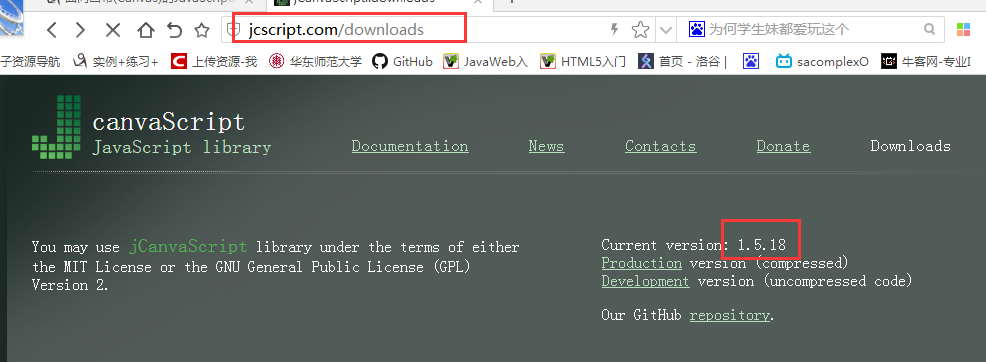





![[Python图像处理] 小波变换执行图像融合](https://img-blog.csdnimg.cn/4c39e49efad34c288c18c41f9fafec8f.png#pic_center)



